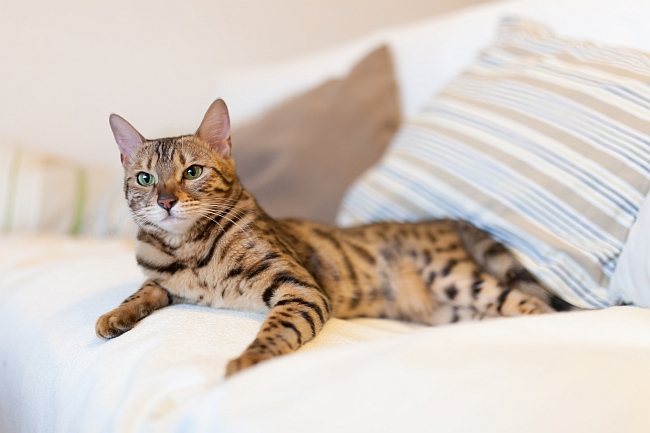
These felines are a far cry from the American tabby cat. Bengals, whether they are golden or snow colored, look wild and fierce despite being loving pets Their markings are distinct, with leopard-like rosettes, and often tend to have larger bodies than most domestic cats can boast. Having a Bengal roam around the house will make any living space feel like an exotic jungle. In recent decades, wild cat and domestic crossbreeds have become popular pets, one of which is the Bengal.
Origin of the Bengal Cat
Though there have been Asian leopard cat breeds noted as early as the 19th century as well as the 1940’s, none of them successfully progress until the 1960’s when the official breeding process began. California breeder Jean Mill bought a stunning Asian leopard cat from a local pet store which once carried the unusual animals in 1963. She noted the cat’s loneliness and later purchased a male domestic cat to keep the leopard cat company. Surprisingly, the cats mated, producing a litter of beautiful kittens. Though only one of them survived, Mill decided to keep crossing breeding her pets in the hopes of stabilizing a future for domesticated Asian leopard cats.
During the primary breeding attempts, there were fertility issues amongst the male cats, and behavioral issues in general with the first few generations. The creatures would be aloof, nervous and uncertain, similar to their leopard cat mother. However, once the cats were bred 3 or 4 generations away from the Asian leopard cat, they behaved much more like typical domestic cats. Mill partnered with geneticist Dr. Willard Centerwall of University of California at Davis, who had studied leopard cats, because of their apparent resistance to the feline leukemia virus. Mill cared for the cats he observed, and continued to search for spotted domestic males who could make with the fertile female leopard cat descendents.
Mill sourced unique spotted males wherever she could find the exact look she wanted; whether it was at a shelter in California or an elephant’s cage at a zoo in Dehli, India.
The developing process was slow, but after the 3rd generation cats had all the right markings and balance of temperament, Mill was determined to continue breeding until the Bengal cat was a recognized breed. After showing her cats, and recruiting other breeders to the same pursuit, The International Bengal Cat Society was established in 1988. In order to be recognized or bred as a Bengal, the breeder must prove that the cats is at least four generations removed from the Asian leopard cat. Bengals are not allowed to be shown in some breeding championships, unless they have proven to be domestically reliable, and four generations away from the wild cat.
Current Breeding
 Like the beautiful Bengals, wild cat hybrids have become increasingly popular over the last few decades.
Like the beautiful Bengals, wild cat hybrids have become increasingly popular over the last few decades.
Because some cat owners are interested in owning a pet with all the characteristics of a wild cat, Bengals are bred in distinction based on how far they are removed from their Asian leopard cat relatives. For example:
- Bengals kittens who have an Asian leopard cat parent are called: F1 (one generation removed- selling for $2,000-4,000 per kitten). These bear a strong resemblance, both in behavior and in appearance to their wild cat parent.
- Kittens with a grandparent who is a leopard cat are called: F2 (two generations removed –costing roughly $2,000-4,000 per kitten.)
- Kittens with a great-grandparent who is a leopard cat are called: F3 (three generations removed- cost between $1,000-2,000.)
- The F4 Bengal is the only cat allowed to be present at feline shows and competitions, since it is four generations domesticated from the wild cat. F4 Bengal kittens usually sell for between $700-1,500. Before purchasing If you are buying a Bengal cat to show, be sure that you choose a F4 cat and have documentation to prove it, or you won’t be allowed to compete.
While witnessing the agility, focus and movement of these cats, it is easy to imagine them stalking prey in a dark forest and exploring in the wild. Though Bengals have all the markings of their Asian leopard cat relatives, they enjoy being around people and make beautiful and entertaining domestic pets. It would appear that Jean Mill succeeded in her endeavor to make Bengals a popular breed in homes across the world.

